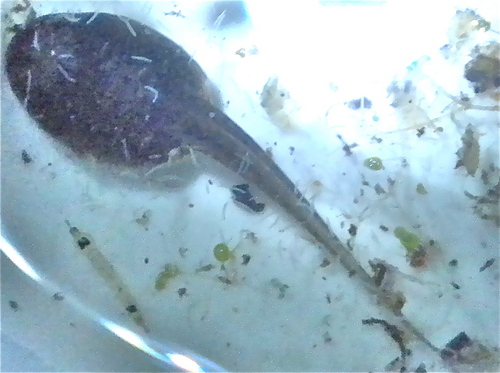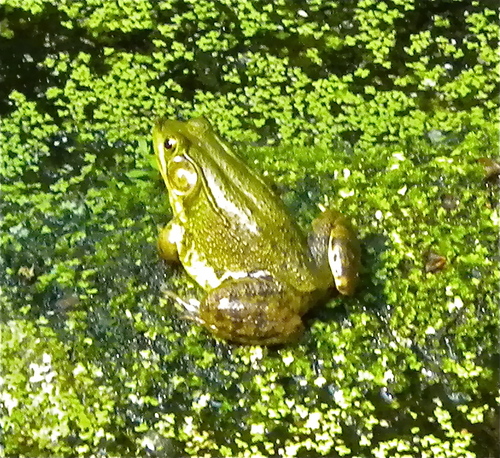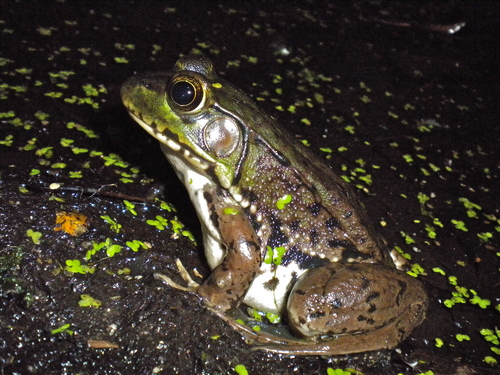Pondcast 26: Green frogs frolic
Are we already halfway through the year? Time speeds on by. Although I enjoy my time at Black Pond, in spite of mosquitoes in the evenings and early mornings, this project has become like work. Next time, I’ll follow in the footsteps of the pond ecologist, Roman Kenk, and only visit a site once every two weeks. That should give me almost enough time to edit the video, examine organisms under the microscope, collect information about them, and write a summary of my discoveries while at the same time taking care of all my other responsibilities, of which I have many.
Week 26, the last week in June, finds Black Pond in early summer. Thousands of flatworms (possibly nematodes) still persist in the water of the pond. They look like a blizzard of cylindrical snowflakes in the dark water of the pond, illuminated by flashlight. I do not recall ever seeing these organisms before this year. I may not have been keyed in to seeing them. Looking at the photos of pond organisms I’ve taken since 2007, these creatures did not appear in any.
These flatworms are easily overlooked, being about 2-3 millimeters long, white in color, and generally spend their time floating in the water, looking like sediment. Were these flatworms introduced by a naturally migrating animal, from an unleashed canine, or by a human using a non-sterile net or footwear? Whatever the case, these organisms are now a significant presence in Black Pond.

Green frog tadpole, phantom midge larva, and flatworms (possibly nematodes).
During my evening visit to Black Pond in Week 26, I encountered a large tadpole, most likely a green frog (Rana clamitans) as this is the largest frog species in Black Pond. Green frog tadpoles undergo metamorphosis within 3-22 months. Tadpoles hatching in June might leave the pond by summer’s end. While tadpoles hatching late in the summer may take 1-2 additional pond cycles to develop, spending the winters in the mud at the bottom of the pond.
Last December Black Pond appeared to be dry. It is conceivable that green frog tadpoles might be able to burrow deep enough to stay moist throughout the dry fall and winter. The mud at the bottom of Black Pond consists of many layers of decomposing leaves instead of clay, sand, or other semi-solid substrate. Earlier this year, when the pond was still covered with ice, I was able to forcibly shove a bamboo pole about 2 meters below the surface, through both water and mud. It is likely that when the pond is at it’s maximum depth, the top meter is liquid water with another meter of mud below.
So, the green frog tadpole I encountered in Week 26 probably hatched late in the summer of 2009 and overwintered in the mud under the pond. Depending on how long the pond stays filled with liquid water, it may undergo metamorphosis this year. Yet, if there is little rain for the rest of the summer and early fall, this tadpole will have to wait until next year to complete it’s growth into an adult.
Not all green frog tadpoles are able to survive the winter. In Week 11 of 2010, once the surface of the pond thawed, Jameson and I encountered several dead green frog tadpoles floating by the boardwalk. These tadpoles probably did not die due to the cold conditions. They most likely died due to the lack of oxygen in the mud in which they overwintered. Perhaps they did not burrow deeply enough or were trapped near the shallow edge of the pond. Since green frog tadpoles continue to feed and grow during the winter, they require oxygen to metabolize their food. If there is not enough oxygen in the mud, they actually starve to death. It’s a good thing that green frogs lay anywhere from 1-7,000 eggs in a summer.

Male green frogs (like this one) should be heard calling throughout the summer at Black Pond. Note his white throat and eardrum are larger than his eye.
Green frogs begin mating in June and continue to do so through August. Males make a breeding call that sounds like a banjo string or rubber band being plucked, “glung.” The first time a female mates in a summer, she lays 3-5,000 tiny eggs in a floating cluster that settle to the bottom of the pond before hatching in about three days.
Green frogs are the largest frog species in Black Pond, attaining a nose to toe length of about 6 inches. Although they can be brown or tan, they are usually green colored on top, with a raised line of skin along their back behind each eye. Males have yellow throats and have an eardrum larger than their eye. Females have white throats and eardrums about the same size as their eyes.

Female green frogs have yellow throats, eardrums about the same size as their eyes, and don't call.
In winter, adult green frogs hibernate under the water of ponds, streams, rivers, and lakes. It is not known if they actually burrow into the mud of Black Pond or spend the winter in the wetlands just to the north. Maybe someday someone will implant tracking devices into these critters to discover their winter habits?
You can see all the Pondcast videos by visiting the YouTube channel of Stefan Szumko, AKA slugwhisperer at http://www.youtube.com/user/slugwhisperer.
Stefan Szumko is a middle school science teacher by trade, an outdoor environmental educator by calling, and a homedaddy by choice. He can be reached at slugwhisperer@gmail.com.

